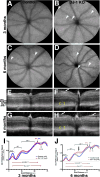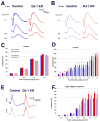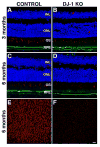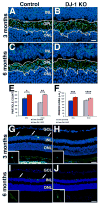Loss of DJ-1 elicits retinal abnormalities, visual dysfunction, and increased oxidative stress in mice
- PMID: 26215528
- PMCID: PMC4573318
- DOI: 10.1016/j.exer.2015.07.014
Loss of DJ-1 elicits retinal abnormalities, visual dysfunction, and increased oxidative stress in mice
Abstract
DJ-1/PARK7 mutations or deletions cause autosomal recessive early onset Parkinson's disease (PD). Thus, DJ-1 protein has been extensively studied in brain and neurons. PD patients display visual symptoms; however, the visual symptoms specifically attributed to PD patients carrying DJ-1/PARK7 mutations are not known. In this study, we analyzed the structure and physiology of retinas of 3- and 6-month-old DJ-1 knockout (KO) mice to determine how loss of function of DJ-1 specifically contributes to the phenotypes observed in PD patients. As compared to controls, the DJ-1 KO mice displayed an increase in the amplitude of the scotopic ERG b-wave and cone ERG, while the amplitude of a subset of the dc-ERG components was decreased. The main structural changes in the DJ-1 KO retinas were found in the outer plexiform layer (OPL), photoreceptors and retinal pigment epithelium (RPE), which were observed at 3 months and progressively increased at 6 months. RPE thinning and structural changes within the OPL were observed in the retinas in DJ-1 KO mice. DJ-1 KO retinas also exhibited disorganized outer segments, central decrease in red/green cone opsin staining, decreased labeling of ezrin, broader distribution of ribeye labeling, decreased tyrosine hydroxylase in dopaminergic neurons, and increased 7,8-dihydro-8-oxoguanine-labeled DNA oxidation. Accelerated outer retinal atrophy was observed in DJ-1 KO mice after selective oxidative damage induced by a single tail vein injection of NaIO3, exposing increased susceptibility to oxidative stress. Our data indicate that DJ-1-deficient retinas exhibit signs of morphological abnormalities and physiological dysfunction in association with increased oxidative stress. Degeneration of RPE cells in association with oxidative stress is a key hallmark of age-related macular degeneration (AMD). Therefore, in addition to detailing the visual defects that occur as a result of the absence of DJ-1, our data is also relevant to AMD pathogenesis.
Keywords: Biochemistry; DJ-1 knockout; Histology; Immunohistology; Morphology; Oxidation; Physiology; Retina.
Copyright © 2015 Elsevier Ltd. All rights reserved.
Figures









Similar articles
-
Absence of DJ-1 causes age-related retinal abnormalities in association with increased oxidative stress.Free Radic Biol Med. 2017 Mar;104:226-237. doi: 10.1016/j.freeradbiomed.2017.01.018. Epub 2017 Jan 11. Free Radic Biol Med. 2017. PMID: 28088625 Free PMC article.
-
Inducible RPE-specific GPX4 knockout causes oxidative stress and retinal degeneration with features of age-related macular degeneration.Exp Eye Res. 2024 Oct;247:110028. doi: 10.1016/j.exer.2024.110028. Epub 2024 Aug 10. Exp Eye Res. 2024. PMID: 39128667
-
DJ-1-dependent regulation of oxidative stress in the retinal pigment epithelium (RPE).PLoS One. 2013 Jul 2;8(7):e67983. doi: 10.1371/journal.pone.0067983. Print 2013. PLoS One. 2013. PMID: 23844142 Free PMC article.
-
Oxidative Stress Regulation and DJ-1 Function in the Retinal Pigment Epithelium: Implications for AMD.Adv Exp Med Biol. 2018;1074:3-9. doi: 10.1007/978-3-319-75402-4_1. Adv Exp Med Biol. 2018. PMID: 29721921 Review.
-
Oxidative stress regulation by DJ-1 in the retinal pigment epithelium.Adv Exp Med Biol. 2014;801:649-54. doi: 10.1007/978-1-4614-3209-8_81. Adv Exp Med Biol. 2014. PMID: 24664754 Free PMC article. Review.
Cited by
-
Prolonged ocular exposure leads to retinal lesions in mice.Exp Eye Res. 2019 Aug;185:107672. doi: 10.1016/j.exer.2019.05.012. Epub 2019 May 22. Exp Eye Res. 2019. PMID: 31128100 Free PMC article.
-
The Exon-Based Transcriptomic Analysis of Parkinson's Disease.Biomolecules. 2025 Mar 19;15(3):440. doi: 10.3390/biom15030440. Biomolecules. 2025. PMID: 40149977 Free PMC article.
-
An inducible form of Nrf2 confers enhanced protection against acute oxidative stresses in RPE cells.Exp Eye Res. 2017 Nov;164:31-36. doi: 10.1016/j.exer.2017.08.001. Epub 2017 Aug 4. Exp Eye Res. 2017. PMID: 28782506 Free PMC article.
-
Comprehensive Perspectives on Experimental Models for Parkinson's Disease.Aging Dis. 2021 Feb 1;12(1):223-246. doi: 10.14336/AD.2020.0331. eCollection 2021 Feb. Aging Dis. 2021. PMID: 33532138 Free PMC article. Review.
-
Microsomal triglyceride transfer protein is necessary to maintain lipid homeostasis and retinal function.FASEB J. 2024 Mar 15;38(5):e23522. doi: 10.1096/fj.202302491R. FASEB J. 2024. PMID: 38445789 Free PMC article.
References
-
- Abou-Sleiman PM, Healy DG, Quinn N, Lees AJ, Wood NW. The role of pathogenic DJ-1 mutations in Parkinson’s disease. Ann Neurol. 2003;54:283–286. - PubMed
-
- Awatramani G, Wang J, Slaughter MM. Amacrine and ganglion cell contributions to the electroretinogram in amphibian retina. Vis Neurosci. 2001;18:147–156. - PubMed
-
- Beatty S, Koh H, Phil M, Henson D, Boulton M. The role of oxidative stress in the pathogenesis of age-related macular degeneration. Surv Ophthalmol. 2000;45:115–134. - PubMed
-
- Bell BA, Kaul C, Rayborn ME, Hollyfield JG. Baseline imaging reveals preexisting retinal abnormalities in mice. Adv Exp Med Biol. 2012;723:459–469. - PubMed
Publication types
MeSH terms
Substances
Grants and funding
LinkOut - more resources
Full Text Sources
Other Literature Sources
Molecular Biology Databases
Research Materials
Miscellaneous

